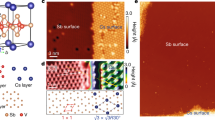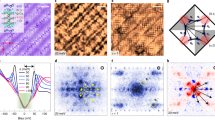Abstract
Despite recent advances in understanding high-transition-temperature (high-Tc) superconductors, there is no consensus on the origin of the superconducting ‘glue’: that is, the mediator that binds electrons into superconducting pairs. The main contenders are lattice vibrations1,2 (phonons) and spin-excitations3,4, with the additional possibility of pairing without mediators5. In conventional superconductors, phonon-mediated pairing was unequivocally established by data from tunnelling experiments6. Proponents of phonons as the high-Tc glue were therefore encouraged by the recent scanning tunnelling microscopy experiments on hole-doped Bi2Sr2CaCu2O8-δ (BSCCO) that reveal an oxygen lattice vibrational mode whose energy is anticorrelated with the superconducting gap energy scale7. Here we report high-resolution scanning tunnelling microscopy measurements of the electron-doped high-Tc superconductor Pr0.88LaCe0.12CuO4 (PLCCO) (Tc = 24 K) that reveal a bosonic excitation (mode) at energies of 10.5 ± 2.5 meV. This energy is consistent with both spin-excitations in PLCCO measured by inelastic neutron scattering (resonance mode)8 and a low-energy acoustic phonon mode9, but differs substantially from the oxygen vibrational mode identified in BSCCO. Our analysis of the variation of the local mode energy and intensity with the local gap energy scale indicates an electronic origin of the mode consistent with spin-excitations rather than phonons.
This is a preview of subscription content, access via your institution
Access options
Subscribe to this journal
Receive 51 print issues and online access
$199.00 per year
only $3.90 per issue
Buy this article
- Purchase on Springer Link
- Instant access to full article PDF
Prices may be subject to local taxes which are calculated during checkout




Similar content being viewed by others
References
McQueeney, R. J. et al. Anomalous dispersion of LO phonons in La1. 85Sr0. 15CuO4 at low temperatures. Phys. Rev. Lett. 82, 628–631 (1999)
Lanzara, A. et al. Evidence for ubiquitous strong electron–phonon coupling in high-temperature superconductors. Nature 412, 510–514 (2001)
Rossat-Mignod, J. et al. Neutron scattering study of the YBa2Cu3O6+x system. Physica C 185–189, 86–92 (1991)
Norman, M. R. et al. Unusual dispersion and line shape of the superconducting state spectra of Bi2Sr2CaCu2O8+δ . Phys. Rev. Lett. 79, 3506–3509 (1997)
Anderson, P. W. Is there glue in cuprate superconductors? Science 316, 1705–1707 (2007)
McMillan, W. L. & Rowell, J. M. Lead phonon spectrum calculated from superconducting density of states. Phys. Rev. Lett. 14, 108–112 (1965)
Lee, J. et al. Interplay of electron-lattice interactions and superconductivity in Bi2Sr2CaCu2O8+δ . Nature 442, 546–550 (2006)
Wilson, S. D. et al. Resonance in the electron-doped high-transition-temperature superconductor Pr0. 88LaCe0. 12CuO4–δ . Nature 442, 59–62 (2006)
d’Astuto, M. et al. Anomalous dispersion of longitudinal optical phonons in Nd1. 86Ce0. 14CuO4+δ determined by inelastic X-ray scattering. Phys. Rev. Lett. 88, 167002 (2002)
Pan, Z.-H. et al. Universal quasiparticle decoherence in hole- and electron-doped high-T c cuprates. Preprint at 〈http://www.arXiv.org/cond-mat/0610442〉 (2006)
Kashiwaya, S. et al. Tunneling spectroscopy of superconducting Nd1. 85Ce0. 15CuO4–δ . Phys. Rev. B 57, 8680–8686 (1998)
Littlewood, P. B. & Varma, C. M. Anisotropic tunneling and resistivity in high-temperature superconductors. Phys. Rev. B 45, 12636 (1992)
Kirtley, J. R. & Scalapino, D. J. Inelastic-tunneling model for the linear conductance background in the high-T c superconductors. Phys. Rev. Lett. 65, 798–800 (1990)
Matsui, H. et al. Direct observation of a nonmonotonic d x 2 − y 2 -wave superconducting gap in the electron-doped high-Tc superconductor Pr0. 89LaCe0. 11CuO4 . Phys. Rev. Lett. 95, 017003 (2005)
Shan, L. et al. An universal law of the superconducting gap in the electron-doped cuprate superconductors. Phys. Rev. B (in the press). Preprint at 〈http://www.arXiv.org/cond-mat/0703256〉 (2007)
Pilgram, S., Rice, T. M. & Sigrist, M. Role of inelastic tunneling through the insulating barrier in scanning-tunneling-microscope experiments on cuprate superconductors. Phys. Rev. Lett. 97, 117003 (2006)
Zhao, J. et al. Neutron-spin resonance in optimally electron-doped superconductor Nd1. 85Ce0. 15CuO4 . Phys. Rev. Lett. 99, 017001 (2007)
Zhu, J. X. et al. Fourier-transformed local density of states and tunneling into a d-wave superconductor with bosonic modes. Phys. Rev. B 73, 014511 (2006)
Lavrov, A. N. et al. Spin-flop transition and the anisotropic magnetoresistance of Pr1. 3-xLa0. 7CexCuO4: Unexpectedly strong spin-charge coupling in the electron doped cuprates. Phys. Rev. Lett. 92, 227003 (2004)
Pintschovius, L. et al. Inelastic neutron scattering study of La2CuO4 . Prog. High Temp. Supercond. 21, 36–45 (1989)
Renker, B. et al. Electron–phonon coupling in HTC superconductors evidenced by inelastic neutron scattering. Physica B 180, 450–452 (1992)
Pintschovius, L. & Reichardt, W. in Physical Properties of High Temperature Superconductors Vol. IV (ed. Ginsberg, D. M.) 295 (World Scientific, London, 1994)
Crawford, M. K. et al. Infrared active phonons in (Pr2–x Ce x )CuO4 . Solid State Commun. 73, 507–509 (1990)
Homes, C. C. et al. Optical properties of Nd1. 85Ce0. 15CuO4 . Phys. Rev. B 56, 5525–5534 (1997)
Lynn, J. W. et al. Phonon density of states and superconductivity in Nd1. 85Ce0. 15CuO4 . Phys. Rev. Lett. 66, 919–922 (1991)
Persson, B. N. J. & Baratoff, A. Inelastic electron tunneling from a metal tip: the contribution from resonant processes. Phys. Rev. Lett. 59, 339–342 (1987)
Hwang, J., Timusk, T. & Carbotte, J. P. Scanning-tunneling spectra of cuprates. Nature 446, E3–E4 (2007)
Scalapino, D. J. Superconductivity: Pairing glue or inelastic tunnelling? Nature Phys. 2, 593–594 (2006)
Eliashberg, G. M. Interactions between electrons and lattice vibrations in a superconductor. Sov. Phys. JETP 11, 696–702 (1960)
Acknowledgements
We thank A. V. Balatsky, E. W. Hudson, P. Richard, G. Murthy, J. Engelbrecht and J. C. Davis for discussions and comments. This work was supported by the NSF and the DOE.
Author information
Authors and Affiliations
Corresponding author
Supplementary information
Supplementary Information
This file contains Supplementary Figures 1-5 with Legends and a brief summary of experimental parameters and methods. (PDF 3524 kb)
Rights and permissions
About this article
Cite this article
Niestemski, F., Kunwar, S., Zhou, S. et al. A distinct bosonic mode in an electron-doped high-transition-temperature superconductor. Nature 450, 1058–1061 (2007). https://doi.org/10.1038/nature06430
Received:
Accepted:
Issue Date:
DOI: https://doi.org/10.1038/nature06430
This article is cited by
-
Evidence for unconventional superconductivity in twisted trilayer graphene
Nature (2022)
-
Imaging the real space structure of the spin fluctuations in an iron-based superconductor
Nature Communications (2017)
-
Coexistence of Weak and Strong Coupling Mechanism, in an Iron-Based Superconductor FeSe 0.5 Te 0.5: Possible Signature of BCS-BEC Crossover
Journal of Superconductivity and Novel Magnetism (2017)
-
Anisotropic Superconducting Gaps and Boson Mode in FeSe 1−x S x Single Crystals
Journal of Superconductivity and Novel Magnetism (2017)
-
Nanoscale determination of the mass enhancement factor in the lightly doped bulk insulator lead selenide
Nature Communications (2015)
Comments
By submitting a comment you agree to abide by our Terms and Community Guidelines. If you find something abusive or that does not comply with our terms or guidelines please flag it as inappropriate.



